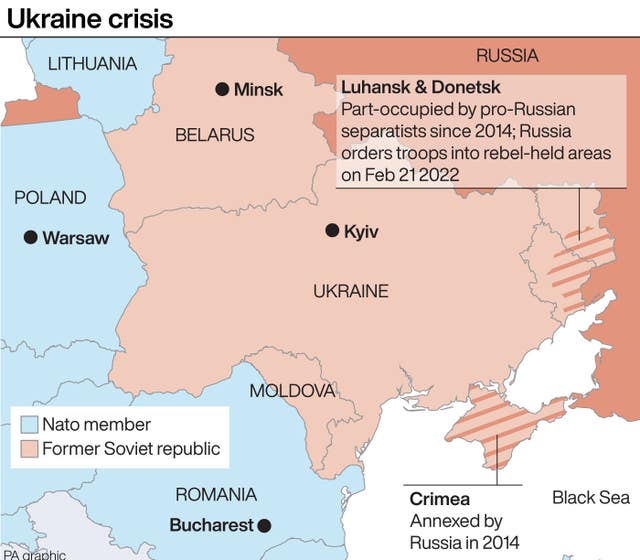Europe braces for further strife as Ukraine crisis escalates
Hopes for a diplomatic way out of a devastating war appeared all but ended.

Europe is braced for further confrontation and Ukraine has urged its citizens to leave Russia after tensions escalated dramatically when Russia’s leader cleared the use of military force outside his country and the West responded with a raft of sanctions.
Hopes for a diplomatic way out of a new devastating war appeared all but sunk as the US and key European allies accused Moscow of crossing a red line in rolling over Ukraine’s border into separatist regions — with several calling it an invasion.

Ukraine’s Foreign Ministry on Wednesday advised against travel to Russia and recommended anyone there leave immediately, saying Moscow’s “aggression” could lead to a significant reduction in consular services.
The head of Ukraine’s National Security and Defence Council called for a nationwide state of emergency — subject to parliamentary approval.
The threat of war has shredded Ukraine’s economy and raised the spectre of massive casualties, energy shortages across Europe and global economic chaos.
Even as the conflict took a dangerous turn, leaders warned it could still get worse. Russian President Vladimir Putin has yet to unleash the force of 150,000 troops massed on three sides of Ukraine, while US President Joe Biden held back on even tougher sanctions that could cause economic turmoil for Russia, but said they would go ahead if there is further aggression.
Ukrainian foreign minister Dmytro Kuleba urged western leaders not to wait.
Responding defiantly to the steps already taken, Russia’s ambassador in the US, Anatoly Antonov, retorted that “sanctions cannot solve a thing” in a statement on Facebook.
“It is hard to imagine that there is a person in Washington who expects Russia to revise its foreign policy under a threat of restrictions.”
In Ukraine’s east, where an eight-year conflict between Russia-backed rebels and Ukrainian forces has killed nearly 14,000 people, violence also spiked again.

Since Friday, when separatist leaders in the Donetsk and Luhansk regions announced mass evacuations into Russia, more than 96,000 residents of the separatist areas have crossed the Russian border.
After weeks of rising tensions, Mr Putin took a series of steps this week that dramatically raised the stakes. First, he recognised the independence of those separatist regions, then he said that recognition extends to the large parts of the territories now held by Ukrainian forces, including the major Azov Sea port of Mariupol.
Finally, he asked for and was granted permission to use military force outside the country — effectively formalising a Russian military deployment to the rebel regions.

But it is unclear if there was any room for diplomacy since the first two demands had been previously rejected by Ukraine and the West as non-starters.
The Russian leader remained vague when asked whether he has sent any Russian troops into Ukraine and how far they could go, and the separatist leader in Donetsk, Denis Pushilin, said on Wednesday that there were no Russian troops in the region.
His remarks contradict those of Vladislav Brig, a member of the separatist local council in Donetsk, who told reporters on Tuesday that Russian troops had already moved in.





